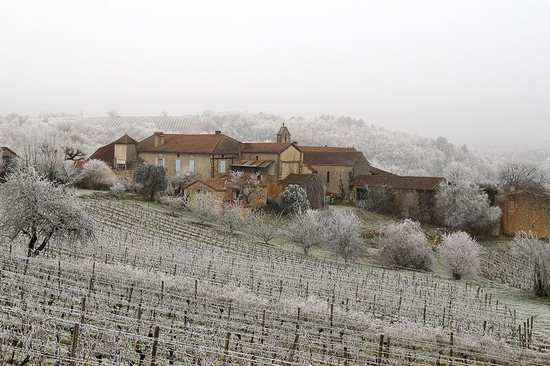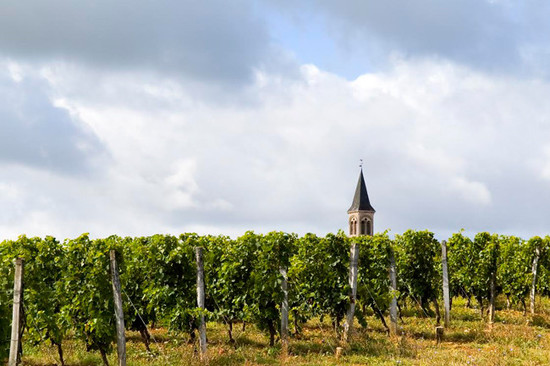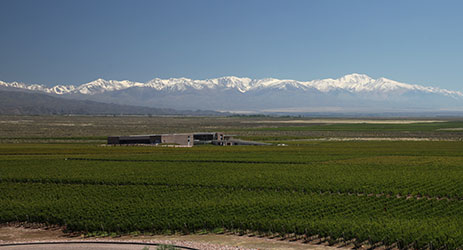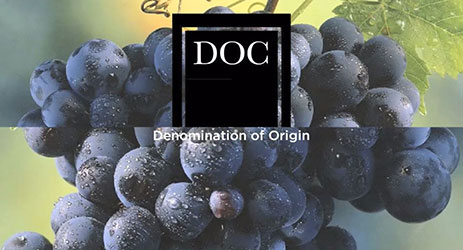At least eight centuries of producing fine red wines for export; a globally recognised grape variety (Malbec) growing in the soils where it first came into being; average land prices of just €11,000 a hectare; and at present only around 4,300 ha of the appellation’s 21,700 ha planted. The quality potential of Cahors for outside investment in French wine remains exciting.
Everyone in the region, moreover, knows that the greatest terroirs are largely unplanted at present: these are the slope sites between the Lot river terraces and the upland limestone causses or plateau land, abandoned after phylloxera and never subsequently reclaimed. “Unlike Pauillac or Pomerol,” says Cahors négociant, château-owner, hotelier and entrepreneur Bertrand Vigouroux, “we have room to expand. As a region, we’re a wine start-up.”

Before you tow your private jet out of the hangar, I should point out that there are also drawbacks: Cahors has poor transport links; reclaiming the slope sites would require huge investment; not all of the 21,700 ha are worth planting; there’s a tradition of fractious local politics here; and wines labelled ‘Cahors’ remain a hard sell. There is much indifferent Cahors sold at lowly prices which degrade the region’s overall reputation, while even great Cahors isn’t an easy wine to understand. (Nor, of course, is great Barolo or Burgundy – but greatness will always find its market.)
For the time being, too, there’s no white-wine appellation to help the red along, though AOP Cahors Blanc unquestionably ought to exist. Yet this is a region which seems set to benefit from climate change, bringing greater vintage regularity to the limestone uplands. Marginal sites here still produce overly acid Malbec wines, even if picked into October; that should change in the decades to come. The Cahors wine picture will be very different in 50 years’ time, I suspect; in a century, it may once again be acclaimed as one of the great red wines of France.
This potential has been spotted in Mendoza. The two regions, of course, share their principal grape variety, though Argentina produces around 10 times as much Malbec as Cahors does. The links were fostered when UIVC President Jean-Marie Sigaud and leading producer Bertrand Vigouroux led a small delegation over to Mendoza in December 2007, including the then-mayor of Cahors, dentist Marc Lecuru, with considerable help from the French consul in Mendoza at the time, Paul Burlot. The trip was a success, and ever since then Vigouroux has produced an inexpensive wine called Antisto, which annually showcases a ‘Malbec Mendoza’ version with a ‘Malbec Cahors’ sibling.
When in Mendoza, he also struck up a friendship with the consulting Californian winemaker Paul Hobbs, who had spent a formative decade working with Catena and who, together with partners Andrea Marchiori and Luis Barraud, has his own Mendoza winery and domain called Viña Cobos. Hobbs had never visited Cahors; he came; he fell in love with it. The joint-venture label Crocus (made by ‘Paul Bertrand’ -- the two partners’ first names) is the result: rich, sumptuous wines brocaded with dark fruits and gently structured with soft tannins and supple acidity.
Other partnerships are now underway here as well. The winemaker for Vieux Télégraphe in Châteauneuf du Pape is a bright young Burgundy-trained Argentinian from San Rafael called Leo Borsi, and he is working with local grower and entrepreneur Pascal Piéron of Ch Bovila and Ch Rouffiac to produce a range of terrace, slope and plateau wines called Clos Ultralocal El Cahors. The name seems a bit of a mouthful, but there’s a story. Borsi already has a Mendoza label called Clos Ultralocal – and ‘Ultralocal’ isn’t the desperate marketing ploy it might appear to be, but a phrase of Dali’s with such a complicated and hilarious history of its own that I can’t resist relating it in a footnote at the end of this blog [1].
Borsi and Piéron’s wines are not bottled yet, but the 2014 samples I have tasted reveal a very different seam of inspiration to the wines if Vigouroux and Hobbs. They are pale and pristine, with shapely, acid-shaped fruit profiles, light tannins and floral notes, while the fruits vary from fresh damson to crab apple.

When I was recently in Cahors, the news was just breaking that Herve Joyaux Fabre of Fabre Montmayou was to invest in Cahors, too, in an as-yet-unspecified project or projects. This is excellent news, for multiple reasons. There is no Mendoza winery for which I have had more long-term admiration than Fabre Montmayou. Joyaux Fabre founded it for the best reasons – after a long search across several international borders, and having tasted what he was looking for, and discovered that it came from Mendoza’s wonderful patrimony of old-vine Malbec.
He was originally a Bordeaux négociant, and he has a sensitive Bordeaux palate (an unrivalled asset when it comes to red-wine creation). This was always evident in the Fabre Montmayou wines, which have had a texture and an innate classiness and finesse from the first. Whatever Joyaux Fabre produces in Cahors will make others sit up and take notice, I’m sure.
It may even make the Bordelais sit up and take notice; they won’t have forgotten him. That in itself would be a positive development, and begin to right a historical injustice [2]. The fact that there is no present-day Bordeaux investment in Cahors is peculiar, given the stylistic kinship between the two wines.
I have left what is perhaps the most exciting ‘tango’ project, though, to the last. Tuscan Antonio Morescalchi (one of the partners in Altos Los Hormigas in Luján de Cuyo) was on a visit to France with Chilean terroir expert Pedro Parra when they visited Cahors and, as Antonio put it, “our eyes went out of their orbits” at the potential they saw, particularly in the limestone sectors of Cahors. I travelled with Antonio and Pedro in January to meet the growers they are working with, and will describe their story in full next week.
To conclude, it’s worth remembering that this is not so much a new relationship as the rekindling of an old one. The French historian Guyonne Blanchy has written a fascinating book detailing the wine history of Mendoza and the role of French pioneers in that [3]. The planting of Mendoza took off during the worst depradations of the phylloxera years: an unrivalled opportunity for Argentina, as it was in all of the non-European vineyards of the time.
Not only did the Mendoza authorities decide that Bordeaux would be their ‘reference viticultural model’, but they also called for ‘disinherited’ French winegrowers to leave their ruined vineyards and come to settle in Mendoza and begin again. By the turn of the C20, some 50 per cent of the Mendoza provincial budget came from wine. The French, in the end, only accounted for around 10 per cent of the bodega owners and landholders, but they tended to fill most of the key technical posts in Mendoza’s early years. Now the compliment is being returned: Mendoza itself is playing a role in the renaissance of a great French vineyard zone.
Notes
1. Few of those using Perpignan railway station today realise this, but Salvador Dali claimed (in his 1964 Diary of a Genius) that all of his greatest ideas come to him here. “A few kilometres earlier, at Boulou, my brain begins to shake, but arriving in Perpignan railway station is the occasion of a true mental ejaculation which attains its grandest and most sublime speculative height.” On September 19th 1963 he had a ‘cosmogenic ecstasy’ of this sort at the station, relating to the tectonic fate of the Iberian peninsula and its hinge at Perpignan railway station. He related this in his 1979 acceptance speech into France’s Académie des Beaux Arts, when he quoted ‘his old friend’ Michel Montaigne: On ne parvient à l'universelqu'àpartir de l'ultralocal (you can only arrive at the universal by starting from the ultralocal). It was, though, a ‘surreal’ quotation which no Montaigne scholar has ever been able to trace. Dali’s 1965 painting La Gare de Perpignan can be seen in Cologne’s Musée Ludwig.
2. Cahors’ long troubles began in 1241, when the English monarch Henry III acceded to requests from Bordeaux merchants not to allow wines from ‘the high country’ to be sold in Bordeaux before Christmas Day each year. (Bordeaux was part of English Aquitaine at the time.) This ‘privilege of Bordeaux’ gave the Bordelais first export rights for each vintage, vitally important in a period when older wine was likely to be spoiled wine.
3. Le Vignoble Argentin de Mendoza et l’Influence Français (Paris: L’Harmattan, 2014)
Translated by Sylvia Wu / 吴嘉溦
All rights reserved by Future plc. No part of this publication may be reproduced, distributed or transmitted in any form or by any means without the prior written permission of Decanter.
Only Official Media Partners (see About us) of DecanterChina.com may republish part of the content from the site without prior permission under strict Terms & Conditions. Contact china@decanter.com to learn about how to become an Official Media Partner of DecanterChina.com.




Comments
Submit